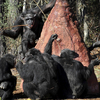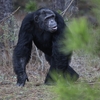
TJ, 35, and Nicole, 41, got here to Chimp Haven from the Alamogordo Primate Facility in New Mexico 2018. One other group is predicted to reach from New Mexico within the coming months.
Kierstin Luckett/Chimp Haven
conceal caption
toggle caption
Kierstin Luckett/Chimp Haven
A gaggle of former analysis chimpanzees in New Mexico that have been beforehand deemed too frail or sickly to be moved to a federal sanctuary will probably be going to that retirement house in any case.
Officers with the Nationwide Institutes of Well being (NIH) stated they reconsidered their resolution to go away the chimps in place after studying that greater than half of the caregivers there anticipate to go away their jobs and retire earlier than July of 2025.
The newest NIH census says that 23 chimps are housed on the Alamogordo Primate Facility (APF), which is situated at New Mexico’s Holloman Air Pressure Base.
This distant, desert location makes it troublesome to recruit the specialised employees that will be wanted to switch the employees who will probably be leaving, NIH officers say.
“We have determined that it makes the most effective sense for the animals to maneuver them,” says Tara Schwetz, the NIH Deputy Director for Program Coordination, Planning, and Strategic Initiatives.
She harassed that these chimps are receiving top quality care the place they’re now. “It is extra a query in regards to the sustainability and the long run capacity to keep up that degree of care,” says Schwetz.
The chimps’ presence at Alamogordo Primate Facility has been controversial for years, with teams such because the Humane Society of the USA questioning the NIH’s dedication in 2019 that each one of those chimps have been too aged or unhealthy to outlive the stress of shifting to a 200-acre sanctuary known as Chimp Haven close to Shreveport, Louisiana.
The NIH, which funds biomedical analysis, stopped supporting invasive analysis on chimpanzees in 2015. However it nonetheless has over 300 chimps to keep up and supply for, as these animals can stay for greater than 60 years. NIH’s objective has been to maneuver as many as doable to Chimp Haven.
Primates at Chimp Haven typically stay in bigger social teams than is typical in analysis services. Additionally they can have entry to wooded, forested areas, though some enclosures at Chimp Haven are much like these present in analysis facilities.
The issue is that as chimps age, they’ll develop the identical critical well being situations that plague older people, comparable to coronary heart illness and diabetes. And altering a chimp’s residing atmosphere may cause extraordinary stress. These extremely social creatures develop bonds with one another in addition to the people that they might have identified for a few years.
So whereas the company has progressively moved most of its chimps from analysis facilities to Chimp Haven, it had stated that probably the most frail chimps, together with all the Alamogordo chimps, would keep the place they have been, for their very own security.
Schwetz notes that lots of the veterinary and animal care employees at Alamogordo “have really labored with these animals for upwards of twenty years or extra, and they also’re actually captivated with offering top quality look after the animals.”
This summer time, nonetheless, Schwetz visited Alamogordo and discovered that almost all of the employees had plans to retire or depart within the not-so-distant future. Because of this, issues about guaranteeing ongoing care modified officers’ calculations about the advantages and dangers of transferring these chimps to the sanctuary.
“We have now to consider the well being and welfare of those animals, initially,” says Schwetz, who provides that NIH is working with Chimp Haven on the right way to greatest switch these chimps, which is a logistically difficult and complicated course of.
“We’re thrilled with their resolution and firmly imagine Chimp Haven is the most effective place for retired chimpanzees to stay out their lives in probably the most pure settings accessible,” Rana Smith, president and chief government officer of Chimp Haven, advised NPR in an e mail.
She stated the refuge anticipated to welcome the primary of those chimpanzees early subsequent 12 months, however might want to assemble a constructing addition to accommodate all of them.
“Earlier this 12 months, Chimp Haven proactively developed architectural plans for growth in case further NIH chimpanzees grew to become eligible to switch to the sanctuary,” Smith stated. “We anticipate the growth will price a minimal of $4 million, which we’ll want to lift from non-public supporters since NIH doesn’t help development prices.”
She says subsequent 12 months is the twentieth anniversary of Chimp Haven’s receiving retired chimps, and that the refuge’s employees is aware of the right way to create a easy transition in order that the Alamogordo chimps can begin residing the great life—or, as Chimp Haven prefers to name it, the Chimp Life.
“We’re assured we are able to safely transition them to the sanctuary,” she says. “We’re excited to offer them the chance to spend the remainder of their lives in a ravishing, forested setting amongst a colony of mates residing the Chimp Life – they deserve it.”







